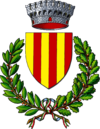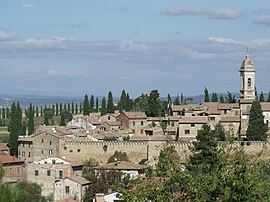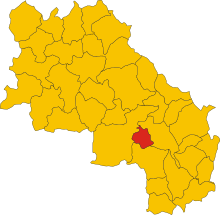San Quirico d'Orcia
| San Quirico d'Orcia | ||
|---|---|---|

|
|
|
| Country | Italy | |
| region | Tuscany | |
| province | Siena (SI) | |
| Coordinates | 43 ° 4 ' N , 11 ° 36' E | |
| height | 409 m slm | |
| surface | 42 km² | |
| Residents | 2,639 (Dec. 31, 2019) | |
| Population density | 63 inhabitants / km² | |
| Post Code | 53027 | |
| prefix | 0577 | |
| ISTAT number | 052030 | |
| Popular name | Sanquirichesi | |
| Patron saint | San Quirico e Giulitta (June 16) | |
| Website | San Quirico d'Orcia | |
 Panorama of San Quirico d'Orcia |
||
San Quirico d'Orcia is a municipality with 2639 inhabitants (as of December 31, 2019) in Tuscany in the province of Siena . The place is known for its unusual portal systems.
geography
The place extends over 42 km² . The place is located in the Val d'Orcia about 35 km southeast of the provincial capital Siena and about 80 km southeast of the regional capital Florence . The rivers Asso , Orcia and Tuoma (9 of 11 km in the municipality) flow through the local area . The place belongs to the Archdiocese of Siena-Colle di Val d'Elsa-Montalcino .
Its districts include Bagno Vignoni and Vignoni (also Castello di Vignoni or Vignoni Alto ).
The neighboring municipalities are Castiglione d'Orcia , Montalcino and Pienza .
history
The place was already inhabited by the Etruscans . The place was first mentioned as San Quirico in Osenna in the 8th century. The place is also mentioned by Sigerich der Ernste in 994, when he lists the place in his description of the Via Francigena as Sce Quiric . In the 13th century the place came to Siena , the city walls were extended and strengthened by their governors until the 15th century. After the defeat of the Senese Republic, the town came under the rule of the Medici in 1559 . Grand Duke Cosimo III. de 'Medici finally gave the place in 1677 as a fief to the then Cardinal Flavio Chigi . After his death, the place was ruled by Buonaventura Zondadari Chigi, and later by Flavio Giuseppe Chigi Zondadari.
Attractions
Collegiata Church
The Collegiata church dates from the 12th century. The large side portal from the workshop of Giovanni Pisano in the late 13th and early 14th century is noteworthy : atlases standing on lions support a short vestibule. Here you can feel that Giovanni was brought up artistically in the French crown lands at the time of the High Gothic and that he apparently effectively passed these principles on to his students. An inkling of the Gothic folds can also be felt here. The whole structure of the portal is Gothic.
This can also be seen in the typically Gothic decorative band that extends over the entire portal zone on both sides of the French cathedral facades at the height of the capitals of the corner columns.
The west portal from the 12th century, which has visibly been heavily restored, is much older. As always in such cases, the two columns of nodes on the far right and left have the function of warding off disaster. The lintel , on which two winged mythical creatures face each other , is particularly interesting . Here elements of various animals have been drawn together, namely those of a dragon, a snake, a crocodile, the scales of a fish and the wings of a bird. Such hybrid creatures do not really belong in Italian art. The reason why they are here of all places can be related to the fact that in the Middle Ages the place was on the Via Francigena and was the seat of a Hohenstaufen vicar in the 12th century.
A nearby place with a similar Nordic theme is the Abbey of Sant'Antimo .
An important work of art within the church is the painting Madonna col Bambino in Trono e quattro Santi by Sano di Pietro , which is on the left in front of the altar. Other important works can be found in the Cappella del Suffragio chapel on the left side of the facade. Mention should be made here of the fresco Madonna del pomo ( Madonna delle Grazie ) by Girolamo di Benvenuto (attributed to) and the painting by Rutilio Manetti ( Madonna del Rosario che salva una ragazza dall'annegamento ).
More Attractions
- Oratorio della Misericordia , building on the back of the Collegiata. Contains on the altar the painting Madonna col Bambino e Santi by Bartolomeo Neroni (called Il Riccio).
- Santa Maria Assunta , also called Santa Maria a Hortos , church in the town center near the Horti Leonini, dates from the 11th century
- Chiesa della Madonna di Vitaleta , in the center of the village, was built between 1867 and 1870 on the remains of the old monastery of San Francesco. Contains the painting Visitazione by Ventura Salimbeni and the wooden statue Vergine Annunciata by Francesco di Valdambrino .
- Cappella della Madonna di Vitaleta , chapel on the road to Pienza, first mentioned in 1590, today private property.
- Ospedale della Scala , branch and grancia of Santa Maria della Scala , originated around 1237.
- Palazzo Chigi , also Palazzo Chigi Zondadari , palace built from 1679 by Carlo Fontana for Flavio Chigi near the Collegiata. Today it houses the town hall.
-
City walls with 14th towers. The two city gates Porta Camaldoli and Porta Ferrea (towards Radicofani) are no longer there today.
- Porta dei Cappuccini , gate towards Pienza, the only remaining city gate of the first city walls from the 13th century. The front gate that existed at the time can only be recognized by the foundations.
- Porta Nuova (New Gate), city gate built in the 14th century.
- Horti Leonini , public Italian garden in the town center, from the 16th century. Created by Diomede Lioni.
- Cappella della Madonna del Riguardo , chapel on the old road to Montalcino (Strada di Riguardo).
- Cappella della Madonna del Rosario , chapel just outside the town center and the Porta dei Cappuccini on the road to Pienza. Made in 15./16. Century, the decorations inside the chapel were made in the 18th century.
- Santa Maria a Tuoma , church ruins approx. 2 km northwest of San Quirico d'Orcia on the Tuoma river. First documented in 1099 and dissolved in 1462.
- Pontaccio , medieval bridge over the Tuoma River approx. 2.5 km north of the town center.
- Cipressi di San Quirico d'Orcia , group of Mediterranean cypress trees on the road to Montalcino.
- Bagno Vignoni with its sights
- Wild asparagus from Tuscany
traffic
- The place is located on the historic Via Cassia as well as on its current route as State Road 2 (SS 2) Via Cassia.
- The place is on the historic Via Francigena .
Sons and daughters of the church
- Pandolfo Petrucci (around 1452–1512), a ruler of Siena
- Mario Heil de Brentani (1908–1982), German writer and non-fiction author as well as a German-Canadian magazine publisher
literature
- I percorsi della Via Francigena nelle terre di Siena. Editrice Le Balze, Montepulciano 2003, ISBN 88-7539-002-9 , pp. 208 ff.
- Wolfram Erber: A Tuscan Jewel - San Quirico d'Orcia: Impressions of the City and Surroundings, Berlin 2017, ISBN 9783745014822
- Emanuele Repetti: S. QUIRICO IN VAL D'ORCIA, già S. QUIRICO IN OSENNA. In: Dizionario Geografico Fisico Storico della Toscana (1833–1846). Online version of the University of Siena (pdf, Italian)
- Bruno Santi: I luoghi della Fede. L'Amiata e la Val d'Orcia. Arnoldo Mondadori Editore , Milan 1999, ISBN 88-04-46780-0 , p. 168.
- Rolf Toman (ed.): The art of the Romanesque. Architecture - sculpture - painting. Könemann Verlagsgesellschaft, Cologne 1996, p. 307. ISBN 3-89508-213-9 .
- Touring Club Italiano : Toscana. Milan 2003, ISBN 978-88-365-2767-0 , pp. 652 ff.
- Klaus Zimmermanns: Toscana. Cologne, 1980 3rd edition 1980. (DuMont Art Travel Guide), p. 345, fig. 80–82.
Web links
Individual evidence
- ↑ Statistiche demografiche ISTAT. Monthly population statistics of the Istituto Nazionale di Statistica , as of December 31 of 2019.
- ↑ Official website of the Sistema Informativo Ambientale della Regione Toscana (SIRA) on the rivers in San Quirico d'Orcia , accessed on September 22, 2016 (Italian)
- ^ A b Castelli Toscani at San Quirico d'Orcia
- ↑ a b c d e f g h Bruno Santi (Ed.): I luoghi della Fede. L'Amiata e la Val d'Orcia.
- ↑ a b c d e Emanuele Repetti: S. QUIRICO IN VAL D'ORCIA.
- ^ A b c Touring Club Italiano: Toscana.
- ↑ a b c I percorsi della Via Francigena nelle terre di Siena
- ↑ Il Tirreno on the Cappella della Madonna del Rosario, accessed on May 24, 2017 (Italian)
- ↑ Archeospot for the Pontaccio bridge , accessed on August 2, 2017 (Italian)
- ↑ Hidden treasure: wild asparagus of Tuscany | FrontRowSociety - The Magazine . In: FrontRowSociety - The Magazine . June 4, 2018 ( frontrowsociety.net [accessed July 24, 2018]).
← Previous location: Torrenieri 7.4 km | San Quirico d'Orcia | Next town: Bagno Vignoni 5.3 km →
![]() Canterbury |
Dover |
Calais |
Wissant |
Guînes |
Licques |
Wisques |
Thérouanne |
Auchy-au-Bois |
Bruay-la-Buissière |
Arras |
Bapaume |
Peronne |
Doingt |
Seraucourt-le-Grand |
Tergnier |
Laon |
Bouconville-Vauclair |
Corbeny |
Hermonville |
Reims |
Trépail |
Châlons-en-Champagne |
Cool |
Brienne-le-Château |
Bar-sur-Aube |
Châteauvillain |
Blessonville |
Langres |
Humes-Jorquenay |
Coublanc |
Grenant |
Dampierre-sur-Salon |
Savoyeux |
Seveux |
Gy |
Cussey-sur-l'Ognon |
Besançon |
Étalans |
Chasnans |
Nods |
Ouhans |
Pontarlier |
Yverdon-les-Bains |
Orbe |
Lausanne |
Cully |
Vevey |
Montreux |
Villeneuve |
Aigle |
Saint-Maurice |
Martigny |
Orsières |
Bourg-Saint-Pierre |
Great St. Bernhard |
Saint-Rhémy-en-Bosses |
Saint-Oyen |
Étroubles |
Gignod |
Aosta |
Saint-Christophe |
Quart |
Nut |
Verrayes |
Chambave |
Saint-Denis |
Châtillon |
Saint-Vincent |
Montjovet |
Issogne |
Verrès |
Arnad |
Hône |
Bard |
Donnas |
Pont-Saint-Martin |
Carema |
Settimo Vittone |
Borgofranco d'Ivrea |
Montalto Dora |
Ivrea |
Cascinette d'Ivrea |
Burolo |
Bollengo |
Palazzo Canavese |
Piverone |
Azeglio |
Viverone |
Roppolo |
Cavaglià |
Santhià |
San Germano Vercellese |
Olcenengo |
Salasco |
Sali Vercellese |
Vercelli |
Palestro |
Robbio |
Nicorvo |
Castelnovetto |
Albonese |
Mortara |
Cergnago |
Tromello |
Garlasco |
Gropello Cairoli |
Villanova d'Ardenghi |
Zerbolò |
Carbonara al Ticino |
Pavia |
Valle Salimbene |
Linarolo |
Belgioioso |
Torre de 'Negri |
Costa de 'Nobili |
Santa Cristina e Bissone |
Miradolo Terme |
Chignolo Po |
San Colombano al Lambro |
Orio Litta |
Senna Lodigiana |
Calendasco |
Rottofreno |
Piacenza |
Podenzano |
San Giorgio Piacentino |
Pontenure |
Carpaneto Piacentino |
Cadeo |
Fiorenzuola d'Arda |
Chiaravalle della Colomba |
Alseno |
Busseto |
Fidenza |
Costamezzana |
Noceto |
Medesano |
Fornovo di Taro |
Terenzo |
Berceto |
Pontremoli |
Filattiera |
Villafranca in Lunigiana |
Bagnone |
Licciana Nardi |
Aulla |
Santo Stefano di Magra |
Sarzana |
Castelnuovo Magra |
Ortonovo |
Luni |
Fosdinovo |
Carrara |
Massa |
Montignoso |
Seravezza |
Pietrasanta |
Camaiore |
Lucca |
Capannori |
Porcari |
Montecarlo |
Altopascio |
Castelfranco di Sotto |
Santa Croce sull'Arno |
Ponte a Cappiano |
Fucecchio |
San Miniato |
Castelfiorentino |
Coiano |
Montaione |
Gambassi Terme |
San Gimignano |
Colle di Val d'Elsa |
Badia a Isola |
Monteriggioni |
Siena |
Monteroni d'Arbia |
Ponte d'Arbia |
Buonconvento |
Montalcino |
Torrenieri |
San Quirico d'Orcia |
Bagno Vignoni |
Castiglione d'Orcia |
Radicofani |
San Casciano dei Bagni |
Abbadia San Salvatore |
Piancastagnaio |
Ponte a Rigo |
Proceno |
Acquapendente |
Grotte di Castro |
San Lorenzo Nuovo |
Bolsena |
Montefiascone |
Viterbo |
Ronciglione |
Vetralla |
Capranica |
Sutri |
Monterosi |
Nepi |
Mazzano Romano |
Campagnano di Roma |
Formello |
La Storta |
Rome
Canterbury |
Dover |
Calais |
Wissant |
Guînes |
Licques |
Wisques |
Thérouanne |
Auchy-au-Bois |
Bruay-la-Buissière |
Arras |
Bapaume |
Peronne |
Doingt |
Seraucourt-le-Grand |
Tergnier |
Laon |
Bouconville-Vauclair |
Corbeny |
Hermonville |
Reims |
Trépail |
Châlons-en-Champagne |
Cool |
Brienne-le-Château |
Bar-sur-Aube |
Châteauvillain |
Blessonville |
Langres |
Humes-Jorquenay |
Coublanc |
Grenant |
Dampierre-sur-Salon |
Savoyeux |
Seveux |
Gy |
Cussey-sur-l'Ognon |
Besançon |
Étalans |
Chasnans |
Nods |
Ouhans |
Pontarlier |
Yverdon-les-Bains |
Orbe |
Lausanne |
Cully |
Vevey |
Montreux |
Villeneuve |
Aigle |
Saint-Maurice |
Martigny |
Orsières |
Bourg-Saint-Pierre |
Great St. Bernhard |
Saint-Rhémy-en-Bosses |
Saint-Oyen |
Étroubles |
Gignod |
Aosta |
Saint-Christophe |
Quart |
Nut |
Verrayes |
Chambave |
Saint-Denis |
Châtillon |
Saint-Vincent |
Montjovet |
Issogne |
Verrès |
Arnad |
Hône |
Bard |
Donnas |
Pont-Saint-Martin |
Carema |
Settimo Vittone |
Borgofranco d'Ivrea |
Montalto Dora |
Ivrea |
Cascinette d'Ivrea |
Burolo |
Bollengo |
Palazzo Canavese |
Piverone |
Azeglio |
Viverone |
Roppolo |
Cavaglià |
Santhià |
San Germano Vercellese |
Olcenengo |
Salasco |
Sali Vercellese |
Vercelli |
Palestro |
Robbio |
Nicorvo |
Castelnovetto |
Albonese |
Mortara |
Cergnago |
Tromello |
Garlasco |
Gropello Cairoli |
Villanova d'Ardenghi |
Zerbolò |
Carbonara al Ticino |
Pavia |
Valle Salimbene |
Linarolo |
Belgioioso |
Torre de 'Negri |
Costa de 'Nobili |
Santa Cristina e Bissone |
Miradolo Terme |
Chignolo Po |
San Colombano al Lambro |
Orio Litta |
Senna Lodigiana |
Calendasco |
Rottofreno |
Piacenza |
Podenzano |
San Giorgio Piacentino |
Pontenure |
Carpaneto Piacentino |
Cadeo |
Fiorenzuola d'Arda |
Chiaravalle della Colomba |
Alseno |
Busseto |
Fidenza |
Costamezzana |
Noceto |
Medesano |
Fornovo di Taro |
Terenzo |
Berceto |
Pontremoli |
Filattiera |
Villafranca in Lunigiana |
Bagnone |
Licciana Nardi |
Aulla |
Santo Stefano di Magra |
Sarzana |
Castelnuovo Magra |
Ortonovo |
Luni |
Fosdinovo |
Carrara |
Massa |
Montignoso |
Seravezza |
Pietrasanta |
Camaiore |
Lucca |
Capannori |
Porcari |
Montecarlo |
Altopascio |
Castelfranco di Sotto |
Santa Croce sull'Arno |
Ponte a Cappiano |
Fucecchio |
San Miniato |
Castelfiorentino |
Coiano |
Montaione |
Gambassi Terme |
San Gimignano |
Colle di Val d'Elsa |
Badia a Isola |
Monteriggioni |
Siena |
Monteroni d'Arbia |
Ponte d'Arbia |
Buonconvento |
Montalcino |
Torrenieri |
San Quirico d'Orcia |
Bagno Vignoni |
Castiglione d'Orcia |
Radicofani |
San Casciano dei Bagni |
Abbadia San Salvatore |
Piancastagnaio |
Ponte a Rigo |
Proceno |
Acquapendente |
Grotte di Castro |
San Lorenzo Nuovo |
Bolsena |
Montefiascone |
Viterbo |
Ronciglione |
Vetralla |
Capranica |
Sutri |
Monterosi |
Nepi |
Mazzano Romano |
Campagnano di Roma |
Formello |
La Storta |
Rome![]()
![]()
![]()







